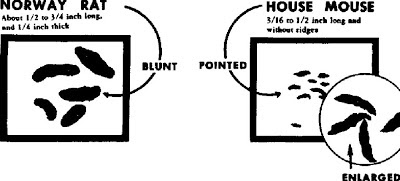If you leave uneaten pet food outside, the rat population will explode. It's that simple.
 |
| Learn to recognize the signs: This is a steaming fresh rat turd on our front stoop next to the "Welcome" mat. Welcome, indeed. |
This problem is two-fold.
- First, people leave pet food and/or bird seed outdoors unattended, never imagining that more than birds or pets might be eating it.
- Second, then when a plague of rodents does predictably mushroom in direct response to this overabundance of food, people fail to recognize the signs, the most obvious of which is droppings such as the one shown above. Not recognizing the signs, they don't modify their pet food management practices.
 |
Learn to recognize the signs: Here are two more turds at the same front entrance, only now you're looking at aged turds which typically become lighter in color and more dried out.
Lately, I've actually had to sweep turds off our front and back porches, there are so many of them. The rats are running wild during the night and their turds are visible the next morning. |
Pet food mismanagement has become a problem at one point or another in every Texas suburban neighborhood I've lived in during the past twenty-odd years. It was not a problem in the recently-built Centerpointe Section 9 until a couple of months ago. When this subdivision was first built,
we had mice. But
mice and rats tend not to occupy the same ecological niche, and it seems that rats have now come in and displaced the original mice.
There are many natural food sources for rats, especially during the growing season, but I'm focusing on pet food because it's so superior for them. Rats are like any other mammalian species - they require the same three
macronutrients (fats, proteins, and carbohydrates) in order to thrive. Pet food optimizes that balance. It frankly amazes me that I now see as much rat activity as I do, and yet I haven't seen a single bit of damage done to any of my back-yard vegetables. But vegetables alone will
disproportionately supply carbohydrates, and no self-respecting rodent would dine on
tomatoes or
squash or
cauliflower or
blueberries or anything else grown in soil when a more complete meal is readily available for them.
 |
| I've currently got about ten million of these things in our back yard, and they remain untouched. |
The rat situation is so bad here right now that we've decided to try a new approach to controlling it.
 |
| Bait stations ordered over the internet. Lots of them. |
Historically, I've dealt with suburban pet-food-driven rat infestations by physically trapping them rather than by poisoning. However, they are best trapped
inside houses, and we are now in the wrong season (summer) for that. And I don't want to leave snap traps or glue traps outdoors at this time of year because both children and other small animals (including
Centerpointe's outdoor cats) can be seriously injured by them.
But baits are not ideal either. They raise the possibility of some rats dying in locations where they can then be eaten by other wild animals or pets, which then ingest the same poison and perhaps proceed to die themselves. Or curious children might contact a carcass, which is potentially dangerous from a disease perspective.
Despite these reservations, we deployed the bait stations anyway. With as much rat sign as we are now seeing, if we don't somehow reduce the population quickly, they will begin moving into our neighborhood houses when the weather gets colder this autumn, as rats will do. And at
that point, we would all have a
much larger problem if they remained unchecked.
I will be going door to door in my section of Centerpointe, asking people about their pet feeding practices and showing them the turd pics above. I encourage folks in other sections of Centerpointe to do similarly.
 |
| Number one rule of rodent control: Deny them their food. |







No comments:
Post a Comment
I'm forced to moderate comments because the spammers have become too much for me to keep up with. If you have a legitimate comment, I will post it promptly. Sorry for the inconvenience.